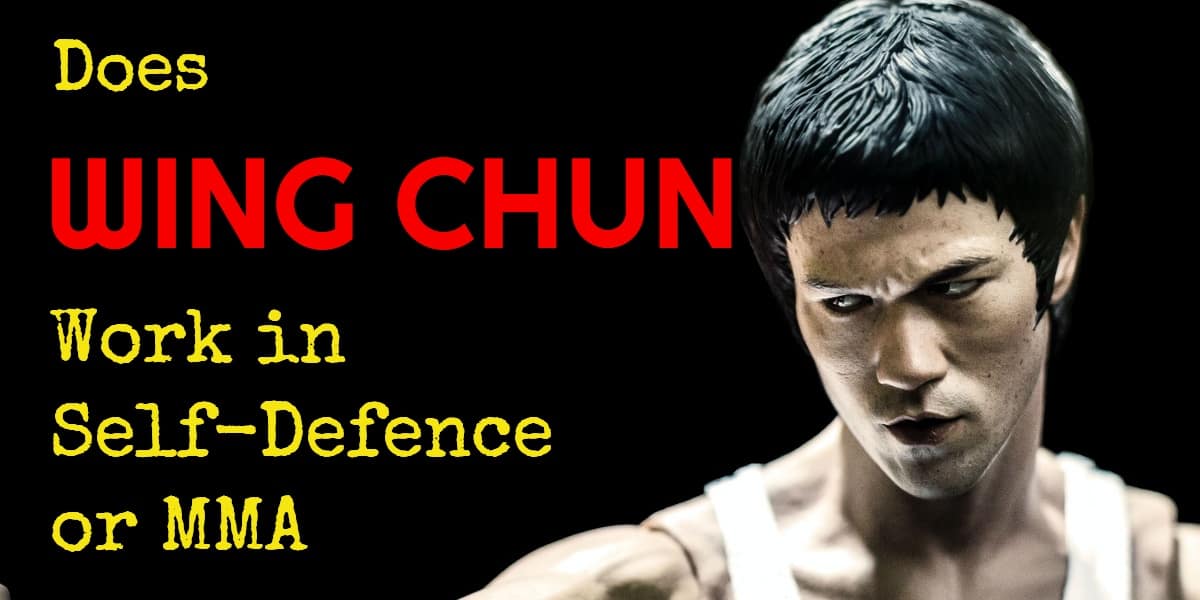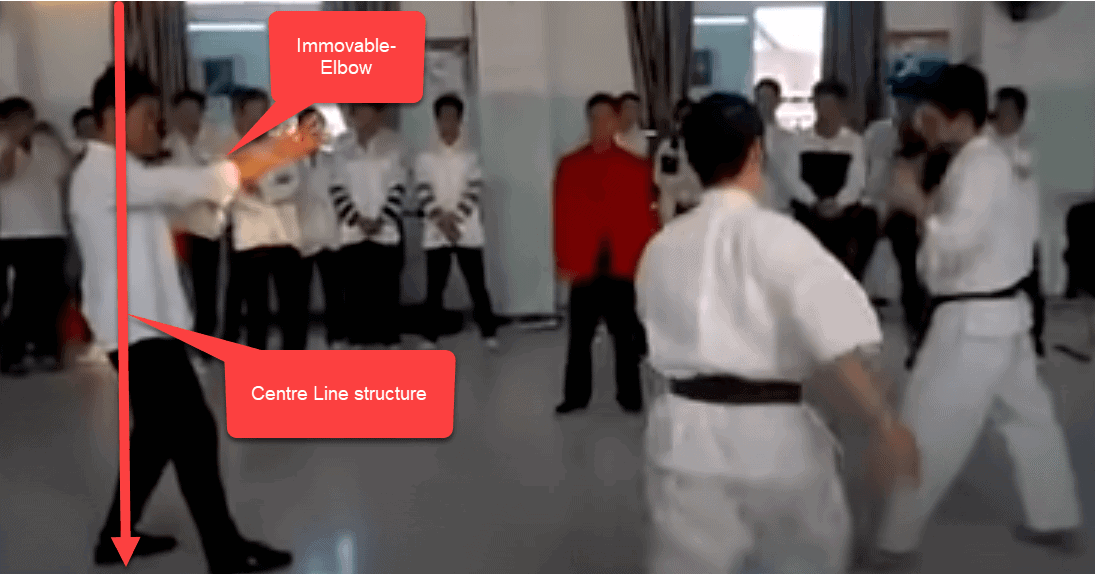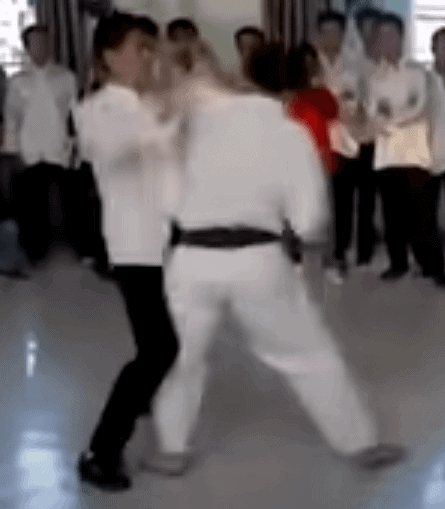Wing Chun is one of the most well known and popular martial arts on the planet.
But does it work in real street self-defence situations or MMA?
Well, in this article, I am going to look at Wing Chun in detail and give you an answer that not only makes sense but is backed by experience.
Ready?
Let's dive in.
What Is Wing Chun?
Wing Chun is a Chinese Martial Art that is part of the Gung Fu family of arts designed to increase a students ability to protect himself and also to achieve a better quality of health and well being.
This family comprises a wide variety of Gung Fu styles such as the White Crane, Praying Mantis Styles.
I have used the word Gung Fu here, but it is merely a variation of dialect, so Kung Fu and Gung Fu are the same things.
Wing Chun is focused on close-quarter combat and short-range vertical grappling techniques that are combined with rapid-fire punches.
Origins Of Wing Chun Kung Fu
Wing Chun was founded by a female named Yim Wing Chun around the reign of Emperor Jiaqing (1796-1820).
Yim Wing Chun was the daughter of a Shaolin Kung Fu master named Yim Yee.
He taught his daughter the art of Kung Fu in secret. However, legend suggests that she was due to marry a Warlord, yet her heart belonged to another.
So she challenged the Warlord to a fight, if she won, she would be free to marry who she wanted.
To defeat the Warlord she teamed up with one of the elders of Kung Fu who taught her a new style.
In the end, Yim Wing Chun defeated the Warlord and years later; the Wing Chun style was taught in China, gaining mass popularity.
Or that's how the legend goes.
Is Wing Chun Any Good For Self-Defence?
Wing Chun is one of the most technically sound Martial Arts in existence.
And it is based mainly around a few solid fundamentals.
The first is what is called 'Centre Line Theory'.
This is where there is an imaginary line that runs directly through your head and through your body to the ground.
It is this centre line that you must protect and of power is generated by rotating your body around this central axis point.
The centre line theory is how modern martial arts such as western boxing and Muay Thai base their striking on. However, in Wing Chun, the objective is to defend the centre line rather than attack the opponent with strikes.
Defence of the centre line provides the Wing Chun practitioner with a goal that allows for both defence and counter-attack, often done simultaneously.
However, the centre line is utilised strongest in what Wing Chun call their 'ready stance'.
This stance is a feature that makes Wing Chun look different than other Martial Arts and can look awkward; however, it is entirely designed to maximise the body.
The Immovable-Elbow Theory
The next aspect of Wing Chun that stands out is the 'immovable-elbow theory'.
The immovable elbow theory is not new to Martial Art and self-defence; however, the origins are likely to be found in Gung Fu.
The arm, when pointed forward and bent slightly, is an incredibly strong structure.
It is challenging to bend the arm in any direction, and far more weight can be held at this angle.
Wing Chun uses this solid structure to parry and deflect strikes that are far more powerful, and also to deal with rush attacks.
This is like having a pole attached to your body that is very difficult to get past.
The 4 Gate Theory
With the stance set up, the immovable elbow in place, the next part of the Wing Chun skillset is the 4 gates.
Essentially this is the division of your body into 4 areas/ quarters of which the Wing Chun practitioner can defend any attack using 8 blocks/ parries.
OK, so there you have the science behind it, but does Wing Chun work?
Should You Use Wing Chun For Self-Defence?
Wing Chun is a surprisingly good martial art for self-defence situations.
The rapid-fire straight blast strikes are challenging for any style to deal with, plus, the stance and immovable elbow make the Wing Chun student a powerhouse in close-quarter situations.
And of course, that is before we even look at aspects such as trapping and strongest weapon nearest the target processes.
But don't take my word for it, let's break down a real Wing Chun self-defence situation.
Real Wing Chun Fight Break Down
OK, so I admit it, this isn't really a self-defence video breakdown, but a match fight between Martial Art styles (Karate is the opponent).
As we can see straight from the out, the Wing Chun fighter gets into his ready stance, and his centre line is strong and his immovable elbow in position.
The karate fighter walks forward where he is met with a low kick.
The Wing Chun fighter uses his rapid-fire straight blast punches to overwhelm the opponent.
This basic premise continues until the Karate fighter throws a haymaker and loses his balance, where the Wing Chun fighter uses some groundwork to defend a failed Omoplata.
Eventually, they get back to their feet and the fight is stopped by the ref.
Watch the full encounter by clicking the play button below.
So, what does this fight tell us?
It shows the effectiveness of Wing Chun, and I do not doubt that if the fight wasn't stopped by the time limit that the Wing Chun fighter would have finished his opponent.
However, what should impress you is that this distinctive 'style' is seen in more old school fight footage between Kung Fun styles.
And it is perhaps more interesting to see how similar Wing Chun looks in real fights when it compares to its movie representations.
But Would It Work In The Street?
Wing Chun is clearly an effective self-defence system, backed by theory and visible application.
However, what about a real street self-defence situation? Perhaps against 2 or 3 attackers?
This is where Wing Chun becomes less effective. It is, in essence, a martial art that deals with attacks that come head-on and on a one on one basis.
But this is the same for most Martial Arts, and as such comparably we cannot criticise Wing Chun for a weakness that other arts also have.
I cannot see any reason why Wing Chun would be less effective than any other form of Martial Arts in self-defence situations.
Can Wing Chun Deal With Powerful Hooks?
There is an argument that where Wing Chun really falls down is when defending against powerful 'hook' style punches.
This is a flawed argument because of the way that Wing Chun works.
The attacker needs to approach you to hook you and as such is there it be struck by the Wing Chun straight strikes.
However, just because it is a flawed argument, it is one that is supported by a lack of mixed sparring by Wing Chun students.
Wing Chun students train against other Wing Chun students and as such, it is an art that as a by-product is great for dealing with low skilled or other straight punch strikers.
So, there will be a weakness that a good hook puncher could exploit because they won't often train against this 'style'.
But the opposite argument does also apply.
A powerful hook puncher will not be used to be dealing with the rapid-fire strikes and trapping of limbs and as such is also vulnerable.
But Wing Chun Never Wins In Sport Style Match Ups
There might be some of you reading that has watched the vast abundance of challenge matches online that feature Wing Chun stylists that never look great.
Firstly, this isn't a Kung Fu movie.
Real fighting is scrappy, chaotic and usually puts 2 people together who don't like fighting. As such, most challenge fights look rubbish.
But challenge fights are a terrible judgement method for deciding if a Martial Art is effective for the street, simply because you might have a low-level fighter representing either or even both Martial Arts.
I mean, let's face it.
Challenging people based on seeing if their Martial Art is effective is such a dumb ass thing to do.
The Verdict
Wing Chun is an excellent Martial Art for self-defence.
There is no real argument against it being a good one that cannot be levelled at any other Martial Art.
However, one argument against Wing Chun is used a lot, the performance of Wing Chun in the MMA arena.
And that is what we are looking at next.
Is Wing Chun Effective In MMA Fights Or Against MMA Fighters?
There is now a generation of people that have never known anything but MMA as the premier Martial Art format.
Yes, millions of people think all other Martial Arts are rubbish unless they are visibly dominant in the Cage.
So, that pretty much means boxing and Muay Thai along with grappling sports such as Sambo, Judo and BJJ.
If you aren't studying one of those Martial Arts, you are pretty much wasting your time.
But how accurate is this?
Well, it's absolute bullshit fuelled by never having stepped into anther Martial Art school, and I'll explain why.
The Fighters Matter Not The Art
There is this belief that a system produces the Martial Artist and not the individual.
That isn't true.
Take me.
I have been grappling for over 20 years and involved in Martial Arts for over 30.
I have boxed, trained in MMA and a lot of others.
I am a product of all of my training.
But let's say I went into Wing Chun.
I studied for 4 years and decided to enter a 'challenge match' against an average MMA fighter, and I was representing Wing Chun.
I would know exactly what the MMA fighter was going to do and be able to show Wing Chun at it's best, win or lose.
But I would be representing Wing Chun in name only.
And that is kind of the point with MMA.
It is every martial art that the fighter has studied.
So, it's not one art that people represent anymore. They are representing themselves.
As such, they train in a variety of martial arts to get the skills they need for the Cage.
But could a person with only Wing Chun experience actually defeat an MMA fighter?
The Environment Dictates Everything In Self-Defence
I know how martial art theory battles like to go.
So, here is the thought process.
Can a traditional Wing Chun specialist beat and MMA fighter?
It all depends on the environment.
If a Cage fighter were to fight a Wing Chun person in the Cage, then, of course, they wouldn't win.
Because it's an MMA arena, with MMA rules that are set up for the MMA fighter.
But what about in a restaurant? Or a busy bar? Or a dark alleyway?
Well, suddenly, the game changes.
Try to take the Wing Chun guy down in a busy restaurant, and you will find things such as walls, tables, physical structures that make it less easy.
And if you manage to do it, expect your most vulnerable targets to be exploited. Your eyes, throat and ears will soon feel attacked until you release your control, giving options for escape and attack.
But even if you did take the Wing Chun person down and were having your way, you are vulnerable to other parties striking you.
This is why challenge matches are a ridiculous way to gauge the effectiveness of an art.
Because MMA is a sport of single combat.
The Verdict
Many MMA fighters such as Anderson Silva and Jon Jones have added Wing Chun elements to their repertoires such as traps and Wing Chun low leg kicks.
But Wing Chun isn't an art that can just walk into MMA and dominate.
Because it was never meant to.
But that doesn't mean it isn't practical as a self-defence system and a worthy art to study, because it is.
So, stop looking at challenge matches as a way to gauge combat skill. Because they aren't a great way to measure anything.
Even in the old day of the Gracie's where King Fu masters would challenge them, no holds barred style.
It was still not an effective judgment because it wasn't self-defence. It was attack.
One where the Wing Chun objective had changed from self-defence to offence.
And one where the goal of the Gracie's was to take the Wing Chun fighter down to the mat, an area where they never trained because they had never needed to.
It was a case that the Wing Chun fighters were suffering from a severe lack of training for their opponents.
Because at that time, they were training an art mostly built for stand up attacks.
Conclusion
Wing Chun works in self-defence.
If it didn't, it simply wouldn't have spread to the degree it has across the world and generations.
However, it merely isn't an art built for MMA.
That doesn't mean it isn't adequate for self-defence or elements cannot be borrowed an inserted into MMA.
But if you are going to enter the Cage, you need a broad mix of skills that are designed to win in MMA matches.
So, if Wing Chun appeals to you, it is not only a fantastic hobby. It is a Martial Art with proven self-defence benefits as well as health ones too.
To sum up, don't let the internet trolls decide which Martial Art is right for you.
Thanks for reading
Andrew
Editor at The Self Defence Expert.com







Dear Andrew, I enjoy reading your articles and appreciate the historical context and perspective you bring! I’m sure you have mentioned this before, and you definitely alluded to this point – that self defense is distinct from fighting. Both are important to know, and having experience in a TMA certainly allows a rich variety of tools to draw from. One can think of “self-defense” as equential steps including situational awareness, …and ending any fight as fast as possible – emphasizing pre-emptive strikes, hard and damaging strikes and movements to target weak areas, and continuous striking until the threat has ended. “Fighting” comes into play when you screw up and lose the element of surprise. With TMAs, there are endless varieties of moves and techniques, some as more general teaching tools, and others for specific instances, and in self- defense situations only a very small fraction of those moves are actually used. As you undoubtedly know, this has been distilled into ‘fighting systems’ that have been very popular – combining fitness as well as self-defense techniques. The popularity is partly due to limited bandwidths of people with their day-to-day jobs – most people don’t want to dedicate their lives to the study of all forms of martial arts so these fighting systems fit their schedule. Now, it is true that in general, everyone needs to make what they find what techniques fits their size, structure, abilities, etc. to be most effective, but I would be curious as what you think the most (let’s say 20?) effective self-defense techniques would be based on your background and experience – ideally from a person with a smaller frame defending against a bigger attacker. It would be great if you could contextualize this, addressing self-defense, and ‘devolving’ into fighting at striking-only long range, closing the gap, addressing hidden potential weapons, additional attackers, etc.
We have this in the works but have a huge post coming soon, so thats taken over. Thanks for such a great comment.
Interesting answer,and a very good one.
People often forget that” Mixed Martial Arts” as understood today is really not ” new” as much as a rediscovery/revisiting of martial arts/disciples/fighting styles, combatives and combat sports from the pre World War era.
In a much earlier era wrestlers/grapplers struck when appropriate and boxers (think the Pre Broughton Rules/James Figg era)were known to utilize other strikes, some catch wrestling and on occasion weapons. The idea was the fighter being able to fight under varying conditions-both as a challenge match/arena and a man-at-arms, Traveler Defense system.
Too many of the recent folks(think all the young kids in Tapout Shirts a few years back)wind up sounding like the Social Media Equivalent of ” My (insert art/gym/discipline/sport here)Is Better Than Yours”… And kinda prove that old point that one never stops learning (if they’re lucky).
A great deal of TMA is useful. As you rightly pointed out,it’s all in the training (BOTH the student and the instructor),how the principles are absorbed and utilized (conditions, single opponent/multiple, survival vs structured match).
And I say that as an old boxer that wandered into a few places.
Regards! Keep on writing!
Thanks, Gregory, you make some really excellent points there. Look back at pre-Quenesberry rules boxing, so much grappling and close-range stuff was a part of it. Thanks for your excellent comment.